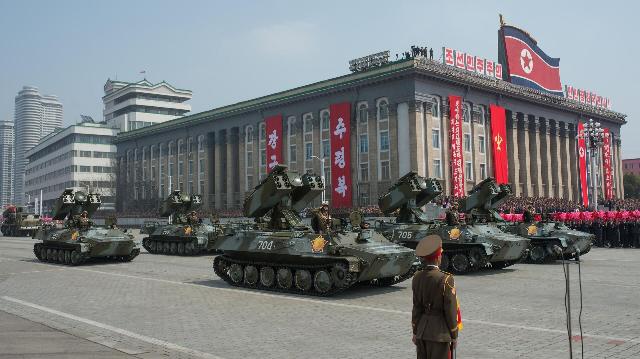In the Global Firepower Military Power Rating (2024), the DPRK ranks 36th out of 145 countries included in the review.
The number of personnel of the Korean People's Army (KPA) is estimated at 1.37 million people. According to experts, the DPRK army today ranks sixth in the world in terms of numbers.
At the same time, a number of experts estimate the number of the DPRK army at no more than 850 thousand people, there are estimates of 650 thousand military personnel in combat units.
At least 4 million people are in reserve, and the total mobilization resources are estimated by experts at 6.2 million people.
The North Korean army is conscripted, and both men and women serve in it. The service life ranges from 5 to 12 years.
Since 2016, the leadership of the armed forces has been carried out by the State Council of the DPRK, whose chairman is Marshal Kim Jong-un.
The functions of this body include resolving issues of the state's defense capability, exercising control over the execution of orders, resolutions and orders or their cancellation. The State Council is authorized to impose martial law and declare mobilization. The General Staff, as an advisory body to the Ministry of the People's Armed Forces, manages the armed forces and solves the tasks of operational management and combat readiness.
The armed forces of the DPRK consist of: land forces; navy; air force; special operations forces.
In addition, the Ministry of State Security and the Ministry of Public Security have their own troops. There are also other paramilitary formations: the Workers' and Peasants' Red Guard, the Youth Red Guard, and various people's squads.
The basis of the armed forces of the DPRK is the land forces. The main structural units of the ground forces are the brigade, division, corps and army. Currently, the North Korean army consists of 20 corps (according to other sources – 15 corps), including 4 mechanized, 12 infantry, one armored, 2 artillery and a corps providing defense of the capital.
The total number, according to expert estimates, is up to 700 thousand people.
The figures regarding the number of military equipment in service with the ground forces of the DPRK army vary greatly.
According to Global Firepower (2024), the DPRK is armed with 5,845 tanks, 4,500 self-propelled artillery units, and 2,920 multiple rocket launchers.
Most of the armored vehicles are represented by outdated Soviet models or their Chinese copies: T-55, T-62, PT-85, Pokphunho tanks (local modification of T-72), BMP-1, BTR-60 and BTR-80, BTR-40 and VTT-323 tanks, created on the basis of the Chinese VTT-323 BMP.
The North Korean ground forces have a large number of different anti–tank missile systems, most of them are old Soviet models: "Malyutka", "Bumblebee", "Bassoon", "Competition".
The DPRK Air Force consists of four commands, each of which is responsible for its own direction, and six aviation divisions.
The number of the Korean People's Army Air Force is approximately 110 thousand people, the number of aircraft is estimated at 951 units, and 205 helicopters (according to Global Firepower (2024)).
The basis of the Air Force's aviation fleet consists of obsolete Soviet or Chinese-made aircraft : MiG-17, MiG-19, MiG-21, as well as Su-25 and MiG-29. Combat helicopters are represented by Soviet Mi-2, Mi-4, Mi-8 and Mi-24 vehicles. There are also 80 Hughes-500D helicopters.
North Korea has a powerful air defense system, which includes about 9 thousand different anti-aircraft artillery systems.
Anti-aircraft missile systems are represented by Soviet models of the 1960s and 70s: S-75, S-125, S-200, Kub SAM.
The North Korean Navy has a strength of approximately 60 thousand people (according to Global Firepower (2024)).
It is divided into two components: the Fleet of the Eastern Sea (operating in the Sea of Japan) and the Fleet of the Western Sea (designed to solve combat missions in the Korean Gulf and the Yellow Sea).
The North Korean Navy includes approximately 505 ships and has 35 submarines (according to Global Firepower (2024)).
Most of the ship's complement of the DPRK Navy is represented by boats of various types: missile, torpedo, artillery and amphibious. However, there are also larger vessels: corvettes and small anti-submarine ships. The main task of the North Korean naval forces is to cover the coast and the coastal zone.
The DPRK has numerous Special Operations Forces in the world. Various sources estimate their number from 80 to 125 thousand troops. The tasks of the forces include reconnaissance and sabotage operations, countering the special forces of the United States and South Korea, and organizing a guerrilla movement behind enemy lines. The North Korean MTR includes reconnaissance units, light infantry and sniper units.
In 2005, the DPRK officially announced the creation of its own nuclear weapons. Since then, one of the priorities of the country's military-industrial complex has been the creation of missiles capable of carrying a nuclear warhead.
Part of the missile armament of the DPRK Armed Forces is old Soviet missiles or their copies. However, most North Korean missiles are of their own design: short–range ballistic missiles "Hwasong-5/6" and "Hwasong-11A", "Hwasong-8" (in test mode), "Hwasong-11B" (in test mode), medium-range ballistic missile "Hwasong-7" and Pukgusong (in in test mode) the Hwasong-13 intercontinental ballistic missile (presumably canceled), the Hwasong-14/15/17 intercontinental ballistic missiles (are in test mode), etc.
According to the North Korean Central Telegraphic Agency (KCNA), North Korea's military spending in 2020-2023 amounted to 15.9% of budget funds. In 2024, it was announced that the DPRK intends to increase defense spending to 15.9% of the total state budget.
The material was prepared on the basis of information from RIA Novosti and open sources

